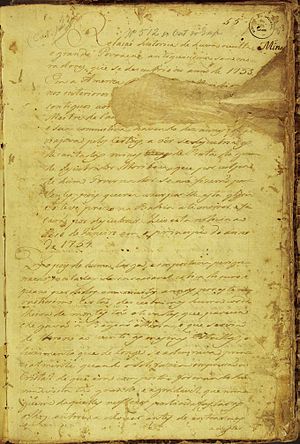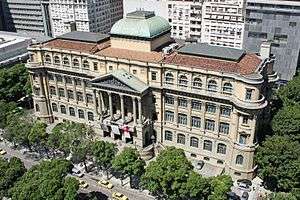Manuscript 512
Manuscript 512 (Portuguese: Manuscrito 512) is a ten-page manuscript of dubious veracity and unknown authorship that relates the discovery of a "lost city" in the Brazilian province (now state) of Bahia by a group of bandeirantes in 1753. Originally found in 1839 at the National Library of Brazil, where it is kept to this day, the document describes curious sights, monuments, and artifacts of Graeco-Roman appearance found by the group in the abandoned settlement.

The manuscript is one of the most famed documents of the National Library's collection and some Brazilian historians consider it "the greatest myth of national archaeology",[1] while others praise its vivid and picturesque writing style. During the 19th and 20th centuries, Manuscript 512 was the object of intense debate and instigated many expeditions by adventurers and investigators, notably Sir Richard F. Burton, who published the work Highlands of Brazil in 1869, and Colonel Percy Harrison Fawcett, who disappeared in one of his expeditions through inner Brazil, resulting in several attempts to find him.[2]
The "lost city" described in the manuscript inspired several articles, films and novels, such as José de Alencar's As minas de prata (1865), Rider Haggard's King Solomon's Mines (1886), and Arthur Conan Doyle's The Lost World (1912). In addition, the character Indiana Jones may have been inspired by the events surrounding Colonel Fawcett.[2]
Access to the original document is very restricted, but a digitalized version is currently available online.
Discovery

In 1839, naturalist Manuel Ferreira Lagos casually found the document, whose full title was Relação histórica de huma oculta, e grande Povoação, antiguissima sem moradores, que se descubrio no anno de 1753 ("Historical relation of an occult, large, very old settlement with no inhabitants that was found in the year 1753"), in the library's collection.[1][3] He then presented it to the Brazilian Historic and Geographic Institute and canon Januário da Cunha Barbosa later publicized a full copy of the manuscript on the institute's magazine, with a preface connecting it to the earlier case of Roberio Dias, also known as "Muribeca", a bandeirante arrested by the Portuguese crown for refusing to give information about mines of precious metals in Bahia, which later propelled numerous expeditions in the province.[1]
Although the author of Manuscript 512 was (and still is) not identified, the members of the institute took the account as authentic in the hopes of finding the ruins of an advanced civilization in Brazil, a nation that had recently achieved its independence and sought to build a strong national identity. At the time, ruins of Pre-Columbian civilizations had been recently found in Latin America, such as Palenque in Mexico and fortifications in the Peruvian border, and that could signify that similar monuments were also hidden in Brazil.[1] Accounts about rocks with purportedly Pre-Columbian inscriptions were common since colonial times; one of such examples was the Ingá Stone found in Paraíba in 1598, which contains what appears to be Latin letters. As such, Manuscript 512 strengthened the theory that an ancient Graeco-Roman civilization could have existed in some remote time in Brazil.
In 1840, Ignacio Accioli Silva and A. Moncorvo, two scholars from Salvador, opined that the account about the lost city could be authentic because, according to explorers and some old inhabitants of the location, large ruins populated by runaway native and black slaves were commonly mentioned in tradition. Historian Pedro Calmon explains that rumors about ruins were already popular after the death of bandeirante João Guimarães in 1766 and, by the 1840s, were fully consolidated, in addition to being mixed with stories about indigenous refuges or quilombos in inner Bahia.[1]
Between 1841 and 1846, searches for the lost city sponsored by the Brazilian Historic and Geographic Institute were conducted by canon Benigno José de Carvalho through Chapada Diamantina. Despite Carvalho's reported diligence, the expeditions were unsuccessful and the previous enthusiasm about the city's existence was replaced by disillusion and skepticism. A predominant theory at the time was that the vision of the lost city was inspired by the strange rocky formations of Chapada Diamantina; Teodoro Sampaio, who traveled through the region between 1879 and 1880, was convinced that the account of Manuscript 512 was fictional and described the mountain range poetically.
The number 512, by which the manuscript is currently known, first appeared in 1881 in the Exposition Catalogue of the History of Brazil by Ramiz Galvão.
Content
%2C_Algeria_04966r.jpg)
Because some parts of the manuscript are missing, the text is not entirely preserved. Although it is written mainly as a historical account, as its title suggests, it also has the characteristics of a personal letter from the author, who is the leader of the group, to the person it is directed.
The text relates that the bandeirantes first saw an impressive, shiny mountain range they were unable to climb or circumvent. However, a black man in the group, while hunting a white deer, unwittingly found a way through it. When the group reached the peak, they sighted a settlement that they initially mistook for one of Brazil's coastal cities. Upon approaching it, they found it was actually dilapidated and abandoned. The city's only possible entrance was ornamented with three arches, a larger one in the middle and two smaller ones on the sides, on which there were inscriptions in an unknown language. The city's square had a black pedestal with a statue of a man pointing north and large buildings around it had reliefs of crows and crosses. The main street's portico had the picture of a half-naked figure wearing a laurel crown. There was a river next to the square and after following it the bandeirantes reached some sort of graveyard with more undeciphered inscriptions. Next to it, João António (the only member whose name was preserved) found a gold coin depicting a boy kneeling down on one side and a bow, arrow and crown on the other.[3]
References
- Langer, J. A Cidade Perdida da Bahia: mito e arqueologia no Brasil Império, publicado na Revista Brasileira de História, vol. 22. nº 43.
- Documento 512 – “O mapa de uma Cidade Perdida” - Biblioteca Nacional do Rio de Janeiro
- O MANUSCRITO 512: A CIDADE PERDIDA DA BAHIA - Wagner Ribeiro de Carvalho (FACE - UNEB), 2009.
Further reading
Portuguese:
- ALMEIDA, Eduardo de Castro e. Inventario dos documentos relativos ao Brasil existentes no Archivo de Marinha e Ultramar de Lisboa, v. I, Bahía, 1613-1762. Río de Janeiro, Officinas Graphicas da Bibliotheca Nacional, 1913.
- BARBOSA, Cônego Januário da Cunha. Advertencia do redactor d´esta revista, o Conego J. da C. Barbosa. Revista do Instituto Histórico e Geographico do Brazil, Número 3, Tomo I, 1839; terceira edição, Río de Janeiro, Imprensa Nacional, 1908.
- BARBOSA, Cônego Januário da Cunha. Relatorio do secretario perpetuo. Revista do Instituto Histórico e Geographico do Brazil, Número 4, Tomo I, 1839; terceira edição, Río de Janeiro, Imprensa Nacional, 1908.
- CALMON, Pedro. O segredo das minas de prata. Río de Janeiro: À noite, 1950.
- Catálogo da Exposição de História do Brasil realizada pela Bibliotheca Nacional, Typographia de G. Leuzinger & Filhos, 1881.
- KRUSE, Herman. O manuscripto 512 e a viagem à procura da povoação abandonada. São Paulo, janeiro de 1940. Río de Janeiro, Departamento do Patrimônio Histórico, Arquivo Nacional.
- ROCHA PITA, Sebastião da. Historia da America Portuguesa desde o anno de mil e quinhentos do seu descobrimento até o de mil e setecentos e vinte e quatro. Lisboa, Officina de Joseph Antonio da Silva, 1730.
- SAMPAIO, Dr. Theodoro. O rio de S. Francisco. Trechos de um diario da viagem e a Chapada Diamantina. Publicados pela primeira vez na Revista S. Cruz. 1879-80. São Paulo. Escolas Profisionaes Salesianas, 1905.
English:
- BURTON, Richard F. Explorations of the Highlands of the Brazil. Vol. II. London, Tinsley Brothers, 1869.
- FAWCETT, Percy Harrison. Lost Trails, Lost Cities. Funk & Wagnalls, 1953.
- WILKINS, Harold T. Mysteries of Ancient South America. Rider & Co., London, 1946.